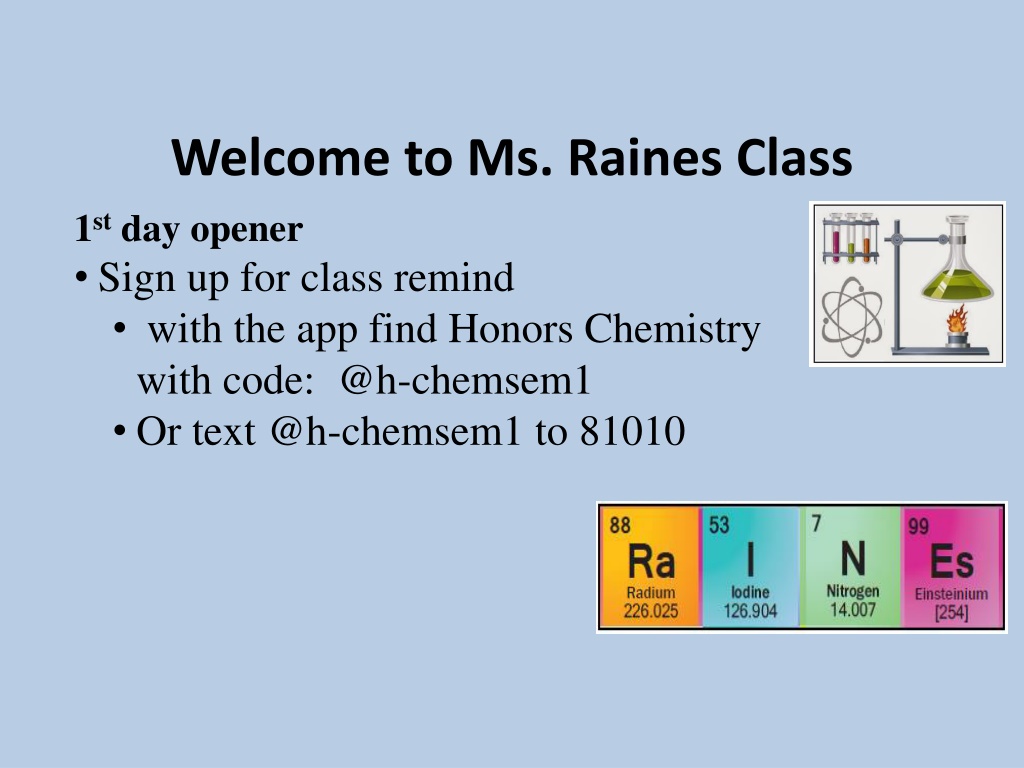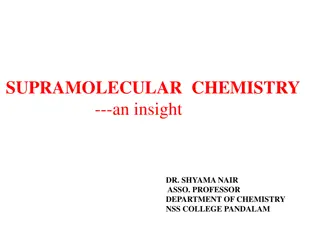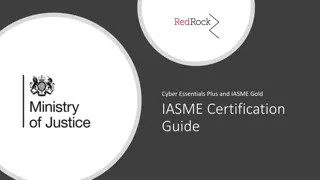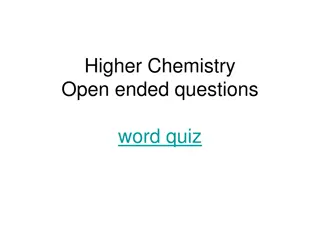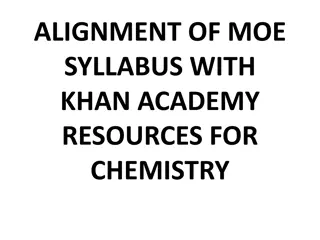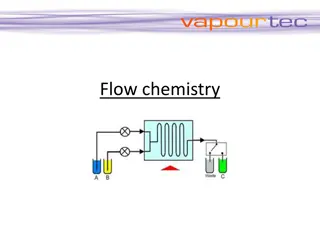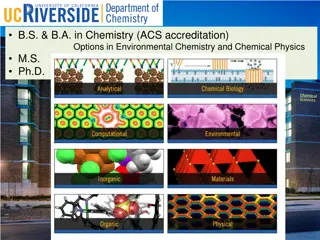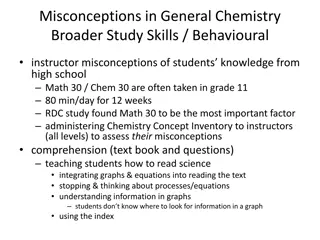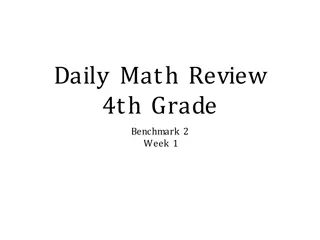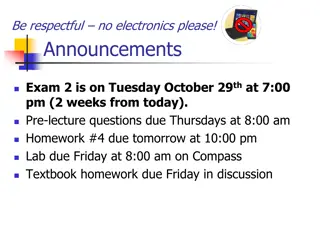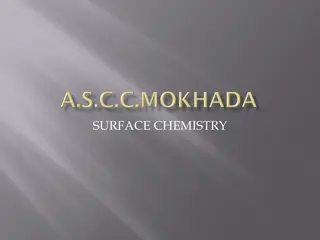Chemistry Class Essentials and Activities for the First Week
Engage in Honors Chemistry through interactive activities like signing up for class reminders, exploring scientific methods, and delving into safety protocols. Discover the scientific method, safety precautions, and guidelines for non-approved science fair topics in a dynamic classroom environment.
Uploaded on Sep 25, 2024 | 0 Views
Download Presentation

Please find below an Image/Link to download the presentation.
The content on the website is provided AS IS for your information and personal use only. It may not be sold, licensed, or shared on other websites without obtaining consent from the author. Download presentation by click this link. If you encounter any issues during the download, it is possible that the publisher has removed the file from their server.
E N D
Presentation Transcript
Welcome to Ms. Raines Class 1st day opener Sign up for class remind with the app find Honors Chemistry with code: @h-chemsem1 Or text @h-chemsem1 to 81010
Day 1 - Agenda Opener: Sign up for remind (see dry erase board) Receive/Review: Syllabus, Student information sheet, [MUST be signed and returned] book request form, [optional] week 1 element list, [home work make 15 flash cards] periodic table, Finn Safety contract Supply list Science Fair info [Honors]
Day 2 Opener Observe the beakers at the front of the room Record color, phase, odor, or other identifying features Test each with pH strips Add pipette of each to sample of baking soda Dip currency in substance and place in Bunsen burner flame.
Scientific Method (3 beaker demo) Scientific method is a logical, systematic approach to the solution of a scientific problem 1. Make observation 2. Ask a question 3. Form a hypothesis 4. Experiment 5. Analyze data 6. Draw Conclusion 7. Develop Theory /law or re-evaluate hypothesis
Scientific Method
Day 3 Opener Answer the following questions on note book paper OR the bottom of you equipment activity. You should use a complete sentence and NOT copy the question 1. When must safety goggles be worn? (3 specific items) 2. What device do you use to get chemicals out of your eyes? 3. What should be done if clothing catches on fire? [3 possible answers] 4. What precautions are necessary for the use of volatile solvents? 5. What precautions are needed with long hair, loose clothing and neckties in the laboratory?
Non-approved Science Fair topics Things to consider when developing topic Must be testable experiment Example: what temperature of water will grow plants the best in darkness? Can NOT be tested, MOST plants need light for photosynthesis Can t test growing (or killing) bacteria at home. This MUST be done in a supervised lab Any experiment that involves people, EVERY person tested MUST sign a consent for testing form. If <18 their parent MUST sign form prior to doing test (this includes surveys) Can NOT do product comparison
Non-approved Science Fair topics what beverage evaporate the fastest? what color candle burns fastest? do ants prefer sugar vs. artificial sweeteners can lemon/oranges/other fruit light an LED bulb how does talking on cell phone influence reaction time which metal is better at conducing electricity which liquid corrodes a rock/nail/(other object) the fastest? does eye color impact vison what food provides most energy what brand of paper towel will work the best what brand of contact solution kills bacteria the best?
Scientific Method
Experimentation Variables are things that change during an experiment Independent variable is the one changed by the scientist [I control, I change] Dependent variable is the one that changes because of what the scientist did. [It depends on what I do] Both can be measured and both can be changed. Constants are things that do NOT change between trails
Scientific Method in the real world Teacher Example: Observation: Hairdryer is not working Question: Why is the hairdryer not working? Hypothesis: not plugged in Experiment: check to see if plugged completely in Data: turns on Conclusion: hairdryer was not plugged Group Example:
Scientific Theory vs Scientific Law Scientific Theory: a well tested explanation for observations and/or experimental result Attempts to explain why or how Can not be proven only can get stronger Kinetic Theory of matter stated atoms are in constant motion and explains how they move Scientific law: a statement that summarizes the results of many observations and experiment Does NOT try to explain why/how Gravity
Measurement Types of measurement Units of measure 12 metric prefixes Significant Figures
Types of measurement Qualitative measurement based on some quality or characteristic Deals with descriptions. Data can be observed but not measured. Colors, textures, smells, tastes, appearance, beauty, etc. Qualitative Quality Blue liquid, soft fabric, cold room
Types of measurement Quantitative measurement is something that is measurable in quantity Deals with numbers. Data which can be measured. distance, volume, mass, speed, time, temperature, cost, ages, etc. Quantitative Quantity 25.0 g, 48 mL, 3 days, 45 miles
Measurement Measuring with SI Units The metric system units are based on multiples of 10 and can be converted easily International System of Units (SI) is a revised version of the metric system The five SI standard units commonly used by chemists are the meter, the kilogram, the Kelvin, the second, and the mole.
SI Base Unit Quantity SI standard unit Base unit** length Mass Temperature Time Volume Meter (m) Kilogram (Kg) Kelvin (K) Seconds (s) Decimeter cubed (dm3) Meter (m) Gram (g) Kelvin (K) Seconds (s) Liter (L) or cubic meter (m3) Mole (mol) Amount of a substance Mole (mol) Heat and Energy Force and weight Joules (J) Newton (N) Joules (J) Newton (N)
Metric Prefixes Added to the base unit to make it larger or smaller Changes by powers of 10 Physical science prefix pneumonic: King henry died by drinking chocolate milk kilo, hecto, deca, base, deci, centi, milli Chemistry has 6 more you may see Tera, Giga,mega, kilo, hecto, deca, base, deci, centi, milli, micro, nano, pico T, G,M, k,h, da, base, d, c, m, , n, p
Pneumonic The Great Mad king Henry died by drinking chocolate milk under nick s porch.
Name Symbol Meaning 1012 109 106 103 102 101 100 10-1 10-2 10-3 10-6 10-9 10-12 Metric Prefix meanings When looking at metric units a unit with only 1 letter is a BASE unit, and units with 2 or 3 letters is a prefix unit Example: Mm is megameters m is meters mm is millimeters Tera T Giga G Mega M Kilo k Hecto h Deca da Base (g, l, m, s) Deci d Centi c Milli m Micro u Nano n Pico P
In general, a calculated answer cannot be more precise than the least precise measurement from which it was calculated. Example: if measuring with a standard ruler and recording the measurements in cm you measurement can only have two decimal places. The line below would be measured at 3.79 cm. _____________
Ruler Example The blue line would be recorded to be 13.3_ cm long. With the _ being the estimated digit. 13.30 cm, 13.31 cm would both be valid measurements. 13.300 cm or 13.310 cm would NOT be valid Read to the unit you are certain of, then estimate one more place.
Graduated Cylinder In order to read the graduated cylinder correctly, it must be placed on a stable surface such as the desk top of the work area And you MUST be at eye level with the meniscus To determine the volume of liquid use the number that is directly at or below the bottom of the meniscus
Graduated Cylinder You must estimate one more digit that you can precisely measure. The graduated cylinder pictured measured in mL and 10th of a mL. The blue liquid would have a volume of 1.11 mL or 1.12 mL. A measurement of 1.110 mL or 1.1120 mL is more precise than the tool allows. Read to the unit you are certain of, then estimate one more place.
Significant Figures and Calculations Complete Significant Figure activity to identify the significant figure rules
Scientific Notation When writing very large or very small numbers, scientists use a kind of shorthand called scientific notation. This is a way of writing a number without so many zeros. Example 1: The speed of light is about 300,000,000 m/s Or 3.0 x 108 Example 2: The mass of a proton is 0.000000000000000000000001673 Or 1.673 X 10-24
All you do is move the decimal so that you only have one number before the decimal. 850,000,000.0 8 5 0 0 0 0 0 0 0 . 0 = 8.5 x 108 For large numbers the exponent is positive!! 0.000,000,025 0 . 0 0 0 0 0 0 0 2 5 = 2.5 x 10-8 For small numbers the exponent is negative!!
Scientific Notation Examples 0.007899 = ? Small number = - exponent 7.899 x 10-3 898745.30 = ? Large number = + exponent 8.9874530 x 105 0.00003657= ? Small number = - exponent 3.657 x 10-5 531120 = ? Large number = + exponent 5.31120 x 105
Getting numbers out of Scientific Notation Look at the exponent of the number to determine if it needs to get smaller or larger Positive exponent means the number get larger so the decimal moves to the right Negative exponent means the number gets smaller so the decimal moves to the left Add zeros to fill in any BLANK spaces
Example 1: 2.35 x 105 The exponent is positive so the number needs to get larger 2 3 5 . 2 3 5 0 0 0. or 235000 Example 2: 8.68 x 10-4 The exponent is negative so the number needs to get smaller . 8 6 8 0. 0 0 0 8 6 8 or 0.000868
Scientific Notation Examples 3.256 x 104 positive exponent = large number 3256 9.78 x 109 positive exponent = large number 978000000000 5.24 x 10-3 Negative exponent = small number 0.00524 2.41 x 10-7 Negative exponent = small number 0.000000241
When rounding first decide how many significant figures the answer should have. Next round to that number of digits , counting from the left. If the number to right of the last significant digit is 4 or less round down, if it is 5 or up round up. Make sure you don t significantly change the value of the original number. Can t round 556 to 6 must be 600 Example: 5,274.827 6 significant figures: 5,274.83 4 significant figures: 5,275 2 significant figures: 5300
Practice A. Round 2.3567 to 3 significant figures B. Round 56913 to 4 significant figures C. Round 2.0132 to 2 significant figures D. Round 5678 to 2 significant figure Answers A. 2.36 B. 56910 C. 2.0 D. 5700
Significant Figures Rules Significant Digits - Number of digits in a figure that express the precision of a measurement instead of its magnitude. Significant figures are just a way of keeping track of our level of precision so that when we do calculations with our data, we don't end up exaggerating it
Significant Figures Rules Simplified Rules for determining whether a digit in a stated value is significant Ignore leading zeros. ( 0.0053 has 2 sig figs) Ignore trailing zeros, unless they come at the end of a number AND there is a decimal point. 35200 has 3 sig fig 35200. has 5 sig fig 35.200 had 5 sig fig Everything else is significant Defined quantities and counted quantities have unlimited number of significant figures. 1 ft = 12 in has sigfigs.
Significant Figures Rules Version 2 Rules for determining whether a digit in a stated value is significant Pacific Atlantic If the decimal point is present, start counting digits from the Pacific (left) side, starting with the first non-zero digit. Example: 0.003100 (4 sig. figs.) If the decimal point is absent, start counting digits from the Atlantic (right) side, starting with the first non-zero digit. Example: 31,400 ( 3 sig. figs.)
Significant Figures Complete Rules Rules for determining whether a digit in a measured value is significant 1. Nonzero digits are significant. 5.23 has 3 significant figures 2. Zeros between nonzero digits are significant. 5001 has 4 significant figures. [Sandwich rule] 3. Zeros at the end of a number and to the right of a decimal place are significant. 1.0100 has 5 significant figures 4. Zeros in front of nonzero digits are not significant, they are only place holders. In general start counting at the 1st NON zero number 0.000099 has 2 significant figures. Start counting at 1st non-zero number. 5. Zeros to the left of an understood decimal point are not significant, they are only place holders. 55000 has 2 significant figures 6. Defined quantities and counted quantities have unlimited number of significant figures. 1 ft = 12 in has sigfigs.
Significant Figures Examples a) 2.03 b) 1.0 c) 0.00860 d) 4.50 x 1012 e) 5.1020 f) 780 g) 780,000 h) 0.78000 i) 50. a) 3 b) 2 c) 3 d) 3 e) 5 f) 2 g) 2 h) 5 i) 2
8-7-17 Opener Identify the number of significant figures in each number then write them in scientific notation 0.000450 2306000 0.00009402 78000 0.002300 80200
Significant Figures and Calculations With multiplication and division the calculation should be rounded to the same number of significant figures as the measurement with the LEAST number of significant figures Example: Calculator give 0.931 12 has only 2 significant figures so the answer must have only 2 significant figures Answer MUST BE 0.93
Significant Figures and Calculations With addition and subtraction the answer must be rounded to the same number of DECIMAL places as the value with the lease number of decimal places. Example: 2.450 14.2 Calculator gives: -11.75 But must be rounded to 1 decimal place so answer is -11.8
Practice Perform the following calculations and round correctly. 2.680 x 0.0051 3.120 / 6 2.45 + 550.9 9.056 4.25 Calculator = 0.013668 = 0.52 = 553.35 = 4.806 Rounded = 0.014 = 0.5 = 553.4 = 4.81
8-8-17 Opener Perform the following calculations make sure to following rounding and significant figure rules. 22.5 + 13.00 8.124 13.6 / 3.300 0.00230 x 22.4 298.50 - 24
Dimensional Analysis is a way to analyze and solve problems using the units of the measurements. It is converting one thing to another without changing its value Requires equality statements and conversion factors. The key to dimensional analysis is to set it up so that the UNITS cancel. All numbers must have a unit! No Naked Numbers!!!!
Many quantities can usually be expressed different several different units Equality Statement shows how two (or more) different units are related Example: 1 dollar = 4 quarters Conversion factor is a ratio of equivalent measurements. Example: 100 ??????? 1 ?????? ?? Whenever two measurements are equivalent, a ratio of the their measurement will equal 1 1 ?????? 100 ???????
When a measurement is multiplied by a conversion factor, the number changes, but the actual size of the quantity measured remains the same. Example: 2.0 hours = 120 minuets = 7200 seconds when using conversion factors the final answer has the same number of significant figures as the starting number
Name Symbol Meaning 1012 109 106 103 102 101 Metric Conversions Tera T Look at your units Largest unit gets a 1 Smallest unit gets 10(x) Giga G Mega M Kilo k Hecto h x= lg exponent- sm exponent Deca da (g, l, m, s) 100 Base Example ____ mL = _____ ML Mega is larger so ML = 1 10(6- -3) ml = 1 ML 10-1 10-2 10-3 10-6 10-9 10-12 Deci d Centi c Mili m Micro u 10(9) ml = 1 ML Nano n Pico P
Example 1 (metric) If a object has a volume of 0.0234 L how much is the volume in pL? recall that to set up equality statement for metrics you need to write 1 Largest unit= 10(x)Smallest unit and x = lg exponent- sm exponent 1 L = 10(0-(-12)) pL 1 L = 1012 pL 1012 0.0234 L ?? ? = 2.34 x 10 10 pL 1
Example 2 (metric) If a student runs 37600 dm how many Mm is it? recall that to set up equality statement for metrics you need to write 1 Largest unit= 10^(x)Smallest unit and x = lg exponent- sm exponent 1 Mm = 10(6-(-1)) dm 1 Mm = 107 dm ?? ?? 1 = 3.76 x 10 -3 Mm = 0.00376 Mm 37600 dm 107
Example 3 (metric) If a object has a volume of 0.00564 daL how much is the volume in pL? recall that to set up equality statement for metrics you need to write 1 Largest unit= 10(x)Smallest unit and x = lg exponent- sm exponent 1 daL = 10(1-(-12)) pL 1 daL = 1013 pL 1013 ?? ??? = 5.64 x 10 10 pL 0.00564 daL 1
